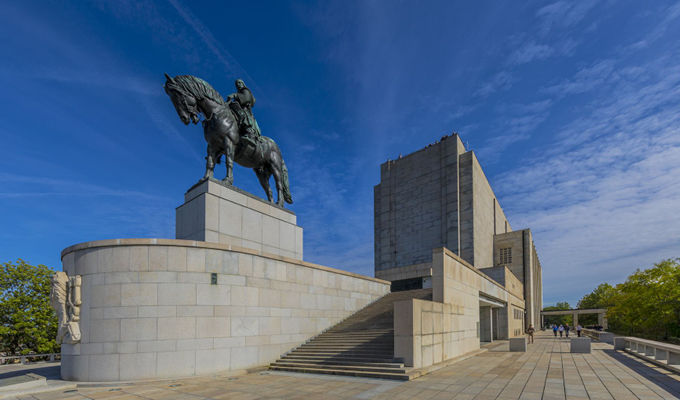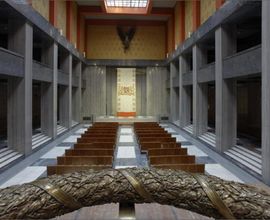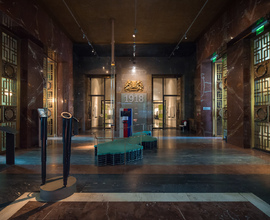Dear visitors,
the National Memorial on the Vítkov Hill has been transferred to the Ministry of Defence since June 1, 2024 and is no longer part of the National Museum. All information on visiting the memorial can be found on the website of the Military History Institute Prague.

History
The National Memorial on the Vítkov Hill reflects the historical experience of the Czech state. Its origins date back to the period after World War I, when the idea to build a monument to the Czechoslovak Legion was born. In 1928 the foundation stone of the National Liberation Memorial was laid. The architectural design was created by Jan Zázvorka. However, the opening ceremony planned for the anniversary of the foundation of the state in 1938 did not take place. Under the Protectorate of Bohemia and Moravia, the Memorial was occupied by the Germans, who used it as a Wehrmacht warehouse. After the end of World War II, the Tomb of the Unknown Soldier was transferred to the Memorial. At present, the remains of an unknown soldier from the battles of Zborov and Dukla are placed here, together with the tomb of General A. Eliáš and his wife.
The largest equestrian sculpture in Central Europe, that of Jan Žižka of Trocnov by the sculptor Bohumil Kafka, is an integral part of the Memorial. Kafka finished the model for the sculpture in 1941, but it was unveiled only on 14 July 1950 on the occasion of the anniversary of the Battle of Vítkov Hill.
In 1948, the Memorial passed to the ownership of the state. Yet its original function was changed, and from 1951 on, important members of the Communist Party of Czechoslovakia were buried here. Two years later, the mausoleum of the first “working class” president, Klement Gottwald, was bulit here. The Mausoleum of K. Gottwald was open until 1962, when the embalmed body was cremated.
After 1989, all the remains were returned to the families of the deceased or buried in the communal grave of the Communist Party at Olšany Cemetery in Prague. In 2000, the National Memorial on the Vítkov Hill became part of the rehabilitation programme for monuments associated with 20th century history, and a year later it became part of the National Museum. Since October 2009, after several reconstructions, it has again been open to the public.
As of June 1, 2024, the National Memorial on the Vítkov Hill passed into the hands of the Ministry of Defense and is now part of the Military History Institute Prague.
-

-
Partially wheelchair accessible
The building is partially wheelchair accessible except for the viewpoint. Our especially trained employees will help you when going up or down a few stairs in the building.
-

-
Entrance with a pushchair
You can enter the building with a pushchair.
-

-
Kids' Corner
There is an unsupervised playroom in the building.
-

-
Cloakroom
Free of charge for visitors.
-

-
Shop
It is located at the ticket office on the ground floor and it offers postcards, souvenirs, professional literature, etc.
-

-
Cafe
Café Vítkov, opening hours are the same as museum opening hours
-

-
Public transport
From Ohrada crossroads (tram, bus station) through the park straight on about 1400 m – from Florenc (bus 175, 133, 207) to U památníku station, then back to the Army Museum and up the hill (difficult terrain)


